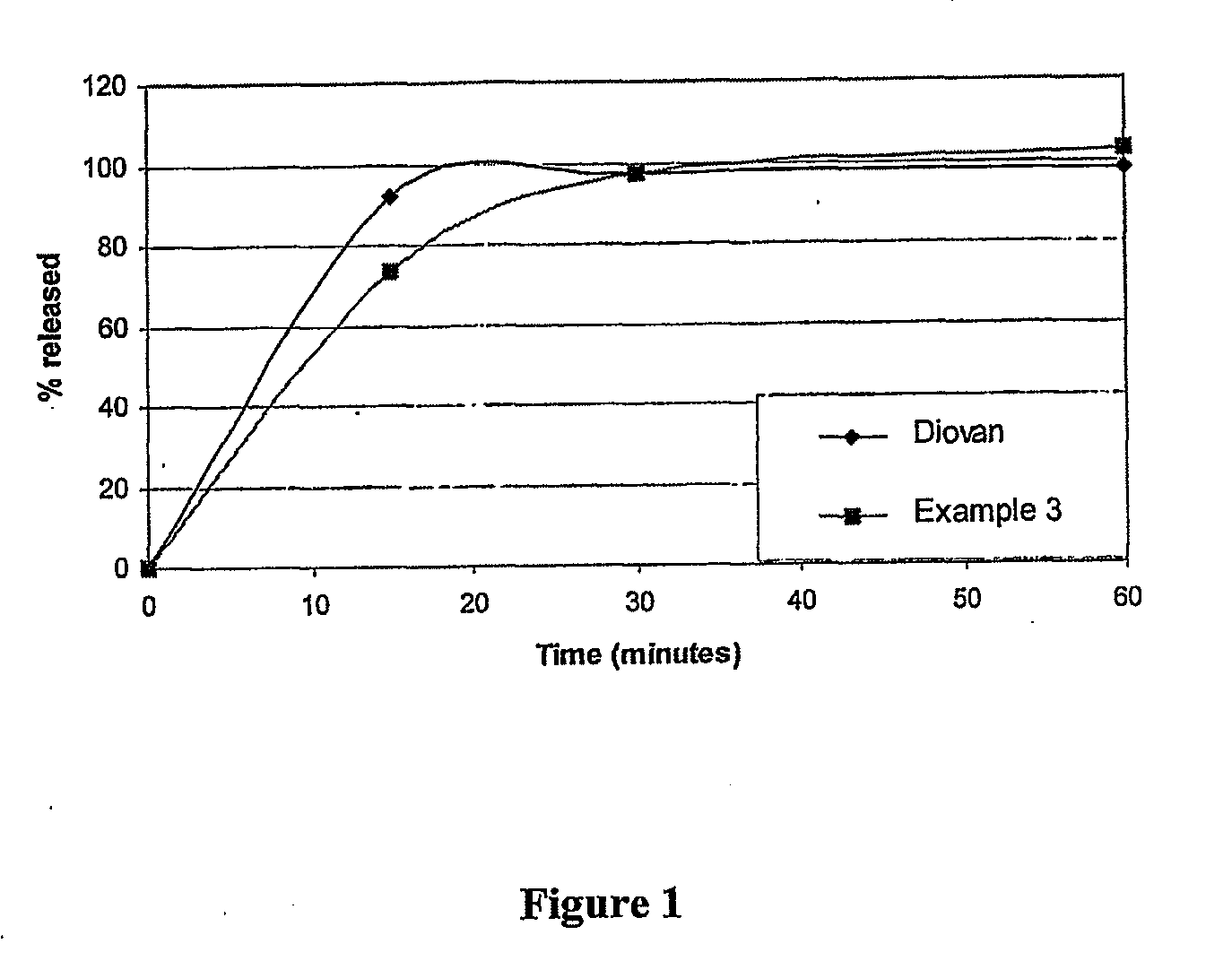Pharmaceutical compositions
a technology of active ingredients and compositions, applied in the field of solid oral dosage forms of hydrophobic active ingredients, can solve the problems of poor flow and static charge, tendency to aggregate, and considerable challenges for formulation scientists
- Summary
- Abstract
- Description
- Claims
- Application Information
AI Technical Summary
Benefits of technology
Problems solved by technology
Method used
Image
Examples
example 1
Formulation of Valsartan with Lutrol as Particle Separating Agent
[0079]A) Treatment of Valsartan with Poloxamer
TABLE 1Composition of the particle separating agent-treated valsartanIngredientsBy weight ratioValsartan80.0Poloxamer 407 USP (Lutrol F127)16.0Microcrystalline Cellulose USP80.0(Avicel PH 102)
[0080]Valsartan was added to molten Lutrol F127 (at about 60-65° C.) under continuous mixing till a uniform semi-solid mixture was obtained. Weighed quantity of microcrystalline cellulose was added to the molten semi-solid mixture under continuous mixing. The blend was then allowed to cool to room temperature and the cooled mass was crushed and passed through 20# sieve.
TABLE 2Comparative physical properties of valsartan and valsartan granulesVasartan treated withBlend PropertiesValsartanLutrolBulk density (g / mL)0.120.393Angle of ReposeCould not be determined38.76Flowas valsartan did not flowSmoothly through 5 mmthrough the funnelorificedespite tapping
[0081]By the treatment of valsartan...
example 2
Formulation of Untreated Valsartan and its Comparison with Lutrol Treated Valsartan
[0085]
TABLE 4Composition of untreated valsartan tablet formulationIngredientsMg / tabletValsartan80.0Microcrystalline Cellulose USP (Avicel PH 102)192.0Colloidal Silicon Dioxide USP (Aerosil 200)6.0Magnesium stearate USP3.0
[0086]Valsartan and microcrystalline cellulose was blended together, lubricated and compressed into tablets.
Disintegration Test
[0087]Disintegration time is found to be highly hardness dependent. Therefore these comparisons were made at two different hardness levels.
TABLE 5Comparison of disintegration time at different hardness levelsDisintegrationtime (min)Hardness (N)Example 2Example 143-5840.66 78-100122
[0088]Formulation comprising untreated valsartan was sticky in nature with poor processability. This resulted in problems of weight variation and sticking during compression.
[0089]It is evident from the above example that treatment with a particle separating agent not only improves p...
example 3
Formulation of Lutrol Treated Valsartan into Tablet with a Disintegrating Agent
[0090]A) Treatment of Valsartan with Lutrol
TABLE 6Composition of the particle separating agent treated valsartanIngredientsBy weight ratioValsartan80.0Poloxamer 407 USP (Lutrol F127)16.0Microcrystalline Cellulose USP80.0(Avicel PH 102)
[0091]Valsartan was dry mixed with microcrystalline cellulose and the blend was granulated using molten Lutrol F127 (at about 60-65° C.) under continuous mixing The blend was then allowed to cool to room temperature and the cooled mass was crushed and passed through 20# sieve.
B) Formulation of Lutrol-Treated Valsartan into Tablet (Disintegrating Agent Added)
TABLE 7Composition of tablet formulationIngredientsMg / tabletValsartan granules as prepared in part A176.0Crospovidone USP (Kollidon.CL)15.0Colloidal Silicon Dioxide USP (Aerosil 200)6.0Magnesium stearate USP3.0
[0092]A weighed quantity of valsartan granules were mixed with microcrystalline cellulose and crospovidone. The b...
PUM
| Property | Measurement | Unit |
|---|---|---|
| particle size | aaaaa | aaaaa |
| Ph | aaaaa | aaaaa |
| concentration | aaaaa | aaaaa |
Abstract
Description
Claims
Application Information
 Login to View More
Login to View More - R&D
- Intellectual Property
- Life Sciences
- Materials
- Tech Scout
- Unparalleled Data Quality
- Higher Quality Content
- 60% Fewer Hallucinations
Browse by: Latest US Patents, China's latest patents, Technical Efficacy Thesaurus, Application Domain, Technology Topic, Popular Technical Reports.
© 2025 PatSnap. All rights reserved.Legal|Privacy policy|Modern Slavery Act Transparency Statement|Sitemap|About US| Contact US: help@patsnap.com

